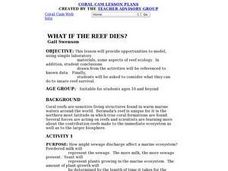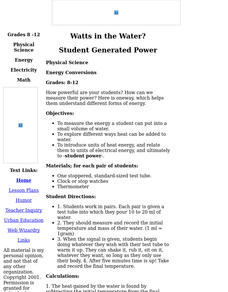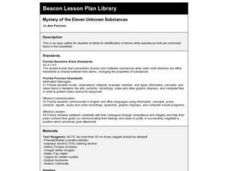Curated OER
Field Trip Preparation
Students make a contingency plan in case of unexpected events such as bad weather. They discuss safety and appropriate conduct.They map out a schedule to ensure that sufficient time is allotted for all activities.
Curated OER
Invertebrates and Vertebrate Evolution
Students explore the major characteristics of the major animal phyla. They describe adaptive features that have contributed to the success of animals on land. Students explain how primate evolution provides a context for understanding...
Curated OER
pH Change and Brine Shrimp eggs
Students determine if brine shrimp eggs hatch and develop more readily in an environment which has an acid or a basic pH. They evaluate the pH level which is optimal for the hatching and development of brine
shrimp.
Curated OER
DOES A FLUCTUATION IN TEMPERATURE IFFECT THE GROWTH AND SURVIVAL RATE OF AQUATIC PLANTS?
Students determine if different temperatures effect the growth and survival rates of aquatic plants and evaluate the optimal temperature for the growth of aquatic plants.
Curated OER
Temperature and Brine Shrimp Eggs
Pupils determine the optimal temperature at which brine shrimp eggs hatch and develop. They evaluate the changes, if any, which occur in a brine shrimp culture at various temperatures.
Curated OER
THe Decomposition of Water
High schoolers collaborate in an experiment where they decompose water into simpler substances through the process of electrolysis. They collect, measure, and observe data and then place the data into a table. Accomodations for...
Curated OER
Physical vs. Chemical Change Lab
Students recognize both a physical and chemical change in different substances. They determine which particles actually changed into different substances, and explain if it represented a physical or a chemical change.
Curated OER
Effects of Nitrate and Phosphate Changes on the Growth of Algae
Students determine the effects of an increase of the amount of nitrate and phosphate levels on the growth of algae. the development of a hypothesis is encouraged and students proceed to a conclusion based on their results.
Curated OER
Organic Materials in an Aquatic Ecosystem
Students evaluate the relationship between oxygen levels and the amount of organic matter in an aquatic ecosystem. They explain the relationship between oxygen levels, bacteria and the breakdown of organic matter using an indicator...
Curated OER
Bleach Chemical Reactions
Students learn what happens when bleach comes in contact with various cloth fibers, chemical colors, nature and synthetics.
Curated OER
What Does That DNA Molecule Really Look Like???
Students extract DNA from animal liver cells. They separate, collect and describe the appearance from the extracted DNA while role playing as an intern in a city's forensics.
Curated OER
DNA Isolation
Students use scientific methods to investigate the concept of DNA. They observe the DNA of human cheek cells. This is done with the use of a lab experience. Students record their observations and reflect upon on how each organism is...
Curated OER
Transformation of E. coli with Antibiotic Resistance
Students participate in an experiment in which they transform an E. coli cell. They discover how the genetic make-up of the cell can be changed by added foreign DNA. They answer questions to complete the lab.
Curated OER
What If the Reef Dies?
Students complete four activities to investigate how reef ecology can change. They perform experiments to show how sewage discharge can affect a marine ecosystem, look at substances that don't dissolve in water, examine wave action...
Curated OER
Down the Drain
Pupils examine the following concepts: If water supplies contain materials which rot or decompose, oxygen is used. Decay and decomposition require vast supplies of oxygen. The use of oxygen for decay of wastes may be a life or death...
Curated OER
Can Bacteria Arise from Non-living Things?
Fourth graders, in groups, determine whether bacteria arises from non-living things,
Curated OER
Beta-Oxidation of Unsaturated Fatty Acids
Students work in small groups to determine the amount of protein contained in an unknown sample. They conduct the experiment, plot the points of absorbency, and present their findings to the class.
Curated OER
Cation Separation and Identification
Students conduct an experiment in which they systematically separate cations from a mixture of substances. They use the following types of reactions to do so: precipitation, acids and bases, oxidation and reduction. They compare a...
Curated OER
Transpiration
Young scholars examine the part that transpiration plays in the hydrologic cycle. They observe how plants play a role in maintaining a stable environment.
Curated OER
DNA Extraction From Living Things
Students extract DNA from split peas. In this biology lesson, students hypothesize what DNA looks like and perform the experiment to verify their hypothesis. They explain the importance of DNA in living things.
Curated OER
Mystery of the Eleven Unknown Substances
Fourth graders identify eleven white substances that are commonly found in the household. They, in pairs, perform experiments on a variety of substances, and must identify them based on the reactions they observe.
Curated OER
ISOLATION OF DNA FROM ONION
Pupils perform a lab in which they extract DNA from onion cells. Students break through the cell and nuclear membranes and then break down the protein that the DNA is wrapped around.























